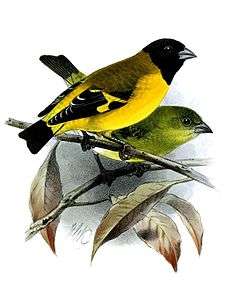Saffron siskin
The saffron siskin (Spinus siemiradzkii) is a species of finch in the family Fringillidae. It is found in Ecuador and Peru. Its natural habitats are subtropical or tropical dry forests, subtropical or tropical dry shrubland, and urban areas. It is threatened by habitat destruction and the IUCN has assessed it as being a "vulnerable species".
| Saffron siskin | |
|---|---|
 | |
| Scientific classification | |
| Kingdom: | Animalia |
| Phylum: | Chordata |
| Class: | Aves |
| Order: | Passeriformes |
| Family: | Fringillidae |
| Subfamily: | Carduelinae |
| Genus: | Spinus |
| Species: | S. siemiradzkii |
| Binomial name | |
| Spinus siemiradzkii (Berlepsch & Taczanowski, 1883) | |
| Synonyms | |
|
Sporagra siemiradzkii | |
Description
The saffron siskin grows to a length of about 10 to 10.5 cm (3.9 to 4.1 in). Like other siskins, the colours of this bird are black, olive and yellow, with black wings with a prominent yellow band on the bases of the flight feathers and another on the wing coverts. The male differs from the male hooded siskin (Spinus magellanica) in having an unstreaked, golden-olive back and bright yellow underparts. The female differs from the female hooded siskin by being altogether yellower, with yellow underparts rather than grey.[2]
Distribution and habitat
The saffron siskin is endemic to southwestern Ecuador and northwestern Peru. It is an uncommon bird found near the edges of dry woodland and in adjoining scrubland at altitudes below about 600 m (2,000 ft).[2]
Ecology
The behaviour of the saffron siskin is similar to that of the hooded siskin but it usually occurs at lower elevations.[2] It feeds mainly on plant material, such as seeds, leaves and buds, but also on insects, foraging among tall grasses and plants and on the ground.[3] It breeds between January and May but little is known of its nesting habits.[3]
Status
This bird is generally uncommon and seldom seen. The total population is estimated to be under 10,000 individuals and is probably in decline because of the conversion of forest for agricultural uses. Despite the bird occurring in the Machalilla National Park and five other protected areas in Ecuador, the International Union for Conservation of Nature assesses it as being a "vulnerable species". The high rate of deforestation in the country adds to the likeliness of the threat that it faces.[1]
References
- BirdLife International (2012). "Carduelis siemiradzkii". IUCN Red List of Threatened Species. 2012. Retrieved 25 July 2016.CS1 maint: ref=harv (link)
- Ridgely, Robert S.; Tudor, Guy (2009). Field Guide to the Songbirds of South America: The Passerines. University of Texas Press. p. 679. ISBN 978-0-292-71748-0.
- Clement, P. "Saffron Siskin (Carduelis siemiradzkii)". Handbook of the Birds of the World Alive. Lynx Edicions, Barcelona. Retrieved 30 July 2016.
